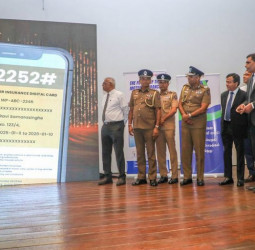President Anura Kumara Dissanayake recently stated that several incentives would be introduced in the future to encourage export diversification and the development of value-added products, noting that relevant sectors would be consulted during the regulation drafting process.
Stakeholders highlight the need for strategising and engaging in proper Research and Development (R&D) in addition to providing incentives in order to ensure export diversification and value addition.
The Sunday Morning Business learns from Deputy Minister of Trade, Commerce, Food Security, and Cooperative Development R.M. Jayawardana that the nature and extent of the incentives are still being discussed and that decisions are yet to be made following discussions with the necessary stakeholders.
While exports to the United States accounted for 23% of total exports, they decreased slightly by 0.73% to $ 252.34 million in June 2025 compared to June 2024. Exports to the US for the cumulative period from January to June 2025 increased by 4.61%, reaching $ 1,434.99 million.
However, the US market, Sri Lanka’s single largest export destination, is showing the repercussions of trade policy uncertainty surrounding reciprocal US tariffs. According to Fitch Ratings’ latest US Consumer Health Monitor, American consumer spending slowed in the first half of 2025. In this light, export diversification, especially market diversification, is deemed as vital.
Export diversification can be primarily divided into two categories: product diversification and destination diversification. Sri Lanka’s cumulative total of both merchandise and services exports was estimated at $ 8,337.86 million for the first half of 2025, marking a notable 6.7% growth compared to the same period in 2024.
Diversifying the market first
Speaking to The Sunday Morning Business, Verité Research Lead Economist Mathisha Arangala noted that it was necessary for Sri Lanka to diversify the market first. He noted that diversification into Asian markets, particularly India, was highly growth-inducing, especially due to its proximity.
Arangala added that in order to effectively achieve product diversification, it was necessary to attract investments, as Sri Lanka lacked the necessary products. He added that in order to secure investments, it was important to showcase what Sri Lanka could offer in addition to what India lacked.
The next step requires assessing the products required by these markets, as they likely will not require the same products exported to traditional markets. Another key strategy, according to Arangala, is joining the supply chain in the industries emerging in the region.
This doesn’t necessarily entail producing the final product but using the opportunities that arise, especially those coming from India, to service those industries, similar to what Southeast Asia did for economies such as Japan and China. He noted that this required attracting and driving investment into these areas as well.
“For this purpose, there are multiple requirements, such as first gaining access to the Indian market and making it easy for investors to invest in the country, as we don’t have certain advantages that India has, such as in terms of market size and labour force. As a small country, one key aspect that Sri Lanka can provide is efficiency, as a large country like India would not be able to provide the same level of efficiency,” he said.
With India holding a significant market size and labour force in the region, Sri Lanka needs to stand out in some aspects. According to Arangala, to improve efficiency, Sri Lanka could focus on trade facilitation, fast-tracking the National Single Window (NSW), and automating and digitising processes. This would make it easy for investors to cater to Sri Lanka in relation to India.
He emphasised that this mindset needed to be adopted, similar to what countries such as Singapore did.
Moreover, he noted the significance of diversifying products as well. Accordingly, for many small countries, it is key to attract one major investor since a catalyst investment can lead to further subsequent success. Arangala explained that many countries chased investments of this nature, assessing how their needs could be accommodated.
“Attracting such investments could lead to a transformation in the export ecosystem in a few years, given that countries like Vietnam doubled or tripled their exports over three to four years due to these types of investments,” he said.
Tax incentives important to attract investments
Many stakeholders also pointed out that financial incentives were a major requirement to facilitate the process.
Highlighting the main barriers, Ceylon National Chamber of Industries (CNCI) Chairman Pradeep Kahawalage noted the requirement for diversifying into other businesses, for which companies required sufficient investment.
He stated that with taxes such as Corporate Income Tax (CIT) and Value-Added Tax (VAT), it was rather challenging for industries to engage in diversification, given the significant investment required for the process. He also highlighted concerns regarding utilities offered to the industry.
“While there are certain constraints regarding taxes, especially concerning the International Monetary Fund (IMF) programme, the industries need to be taken care of. Taxes remain high, especially with CIT at 30% and VAT at 18%, with utility prices also increasing often. This creates a challenging situation for both diversification and value addition. Hence, the Government must address these concerns of the industry,” he noted.
As the Government also needed to pay the interest on debt and capital, he acknowledged that it was also constrained in its ability to provide such tax incentives. However, he added that perhaps in about two years’ time, the Government may be in a position to offer relief to the industry on these terms and streamline diversification.
Encouraging R&D is a necessity
Highlighting current industry requirements, National Chamber of Exporters (NCE) Secretary General/Chief Executive Officer (CEO) Shiham Marikar noted the need for better integration of R&D in the industry.
Stating that the NCE always promoted value addition over the mere export of commodities, Marikar emphasised the need to drive exporters to engage effectively in R&D and to motivate and encourage them to do so. He stated that except for large-scale exporters, many in the Small and Medium-sized Enterprise (SME) and smaller-scale categories barely engaged in, or did not engage in, R&D. According to Marikar, the main reason behind this is the cost involved.
“Hence, we are requesting the Government to provide some form of incentives in relation to R&D. Not a cash incentive but perhaps a double/triple tax reduction to encourage and motivate SME exporters especially to engage in R&D. Even for internal diversification, R&D is essential.
“We will request this in our budget proposal to the Government. We support the views of the President regarding incentives for promoting diversification and value addition. This is where Sri Lanka could discover and reach niche markets and establish a strong pricing structure,” he said.
Marikar further highlighted that new avenues for value addition and innovation could only be effectively discovered through proper R&D. He added that the NCE was currently preparing a set of proposals to be given for Budget 2026 after having gathered inputs, adding that the proposals would be submitted to the relevant authorities soon in order to streamline and improve exports.
“We also encourage our members to really engage in product diversification. Diversification of markets is also valuable, as exemplified by the recent tariff situation. Market diversification, however, requires working very closely with the Sri Lankan missions overseas, especially with trade officers, where the requirements, especially emerging ones and trends, should be communicated back to Sri Lankan exporters through chambers in a timely manner,” he stressed.
Financial incentives and encouraging exporters
Moreover, Imperial Teas Group Chairman and Managing Director and former President of the NCE Jayantha Karunaratne highlighted that Sri Lanka had the potential for significant diversification, a critical factor in all exports. He noted that value addition, essentially being part of diversification, would also contribute to cultivating innovation within the country as well, while bringing new business into the export industry.
“Diversification and value addition have always been sought by the industry. What is important in order to get exporters to work in this direction is not simply being limited to planning, but both encouraging and supporting exporters to engage in it, as many already do this to a certain extent. Thus, encouraging exporters is essential,” he said.
Hence, he noted that financial incentives were vital, with one key requirement being the reduction of CIT, as it remained one of the highest in the world and one of the largest issues that exporters faced.
Moreover, addressing structural barriers that impacted diversification and value addition, he highlighted several key aspects such as import restrictions, procedures, and approvals, in addition to many other barriers that needed clearance.
SL’s next best options
Meanwhile, Free Trade Zone Manufacturers’ Association (FTZMA) Chairman Dhammika Fernando highlighted Sri Lanka’s next-best diversification options, especially with the US consumer market changes. He highlighted the United Kingdom as the fastest to scale for apparel and light manufacturing.
Fernando explained that the UK’s Developing Countries Trading Scheme (DCTS) was liberalising rules of origin for garments, removing the double transformation rule and allowing 47.5–100% of inputs to be sourced externally, with the process being planned for entry in early 2026. He also stated that this made Sri Lankan value-added cut-and-sew more viable, even with imported fabrics/trims, noting that buyer conversions must commence now.
He highlighted the European Union (EU) with stable demand and the Generalised System of Preferences Plus (GSP+) being valid until 2027 as another significant option.
“The EU GSP+ preferences are extended through 2027 and the EU already accounts for roughly a quarter of Sri Lanka’s exports. It’s a good runway for non-US shifts if compliance is maintained,” he noted.
Reaching India and scaling next-door under the Indo-Sri Lanka Free Trade Agreement (ISFTA) is another key move, according to Fernando, with the ISFTA being fully in force and India remaining a top market ($ 829.7 million in 2023). With garment quotas and duty preferences existing, he added they could be used to hedge the US impact and shorten lead times through South Asian supply chains.
He also noted Thailand as an important option, especially with the Sri Lanka-Thailand FTA opening processed foods, rubber, gems/jewellery, and services and with both sides moving to expedite implementation in 2025, where early movers could lock shelf space.
Fernando also believes that beyond merchandise, Sri Lanka should leverage the UAE’s logistics and recent investment protection ties to anchor distribution and capital for exporting clusters. Moreover, as US tariffs don’t directly tax services, he highlighted the need to deepen EU/UK/Gulf Cooperation Council (GCC)/Japan client pipelines for Information Technology and Business Process Management (IT-BPM) as well as maritime services while maintaining goods trade rebalances.
Commenting on structural barriers holding back diversification, one major aspect he highlighted was tax and liquidity uncertainty for exporters.
“The shift from Simplified VAT (SVAT) to a cash-refund VAT regime targeted for 1 October risks refund delays and working capital strain unless the risk-based system is truly fast and digital. Exporters and industry bodies have flagged the liquidity risk. Moreover, there are also energy price volatility/predictability concerns. The IMF’s prior actions required restoring cost-recovery pricing and operationalising automatic tariff adjustments, essential for investment planning in value-added manufacturing,” he pointed out.
Fernando also noted trade facilitation and logistics frictions, highlighting that Sri Lanka improved to 73 out of 139 on the World Bank’s Logistics Performance Index (LPI) in 2023, but still lagged on Customs processes time and reliability for new market entry.
“Ad hoc incentives and policy risks need to be addressed as well. The IMF has repeatedly cautioned against new tax exemptions, urging a rules-based framework,” he noted.
Fernando also highlighted several incentives critical to push value-added products and still align with the IMF Extended Fund Facility (EFF).
He pointed out the need for guaranteed VAT refunds that were legislatively time-bound, risk-based e-refunds, automatic interest for delays, and bankable refund certificates, which could replace SVAT without starving exporters while also being consistent with IMF guidance on administration over exemptions.
“Duty remission and drawback at scale are important, expanding bonded warehousing and streamlined drawback for inputs into value-added exports such as apparel, rubber, tech, and electronics assembly. There is also a need for accelerated depreciation and R&D/design credits, which are also time-bound and rules-based (sunset clauses) to upgrade machinery, product development, and sustainability features such as traceability, low-carbon processes, etc.,” he said.
Moreover, according to Fernando, ensuring export finance by improving pre-/post-shipment credit and forex hedging facilities for SMEs; ring-fencing an export-import-style window; standards and testing support, including co-fund product certification (EU/UK); and fast-tracking mutual recognition are crucial, especially for non-apparel diversification. He added that plug-and-play clusters, such as serviced zones with reliable power, as well as resources were important.
Furthermore, Fernando stated that proper market diversification could take 1–5 years, depending on the strategy taken.
“Realistically, measurable market-share rebalancing, for instance, trimming US share by 5–8 percentage points while growing UK/EU/India/GCC shares, is a 2–3 year journey if the above incentives and facilitation are executed credibly,” he said.



 Natasha
Natasha





